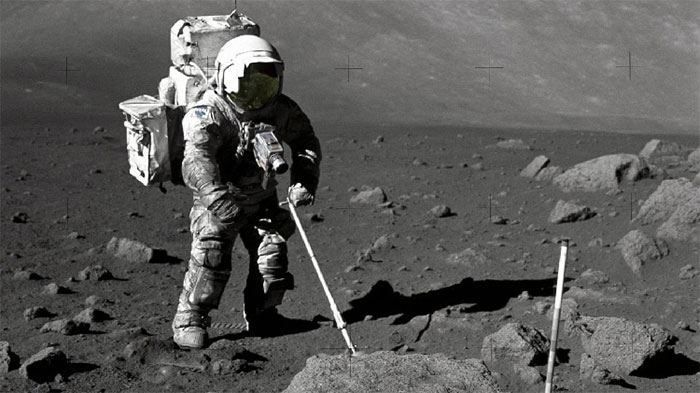Information from the dust of the Moon for the first time
Analyzing dust sticking on astronauts' gloves, the researchers found iron, water and helium in moon dust.
Researchers at the University of Chicago have found a way to conserve moon samples from Apollo missions using atomic tomography (APT) . This is the first time we can see the composition and location of atoms in small particles.

Moon dust particles are taken from astronaut gloves during Apollo mission.Photo: Chicago News).
To analyze the particulate matter, the team prepared a sample of only a few hundred atoms wide, then separated the sample with a focused beam of charged atoms and a laser . APT technology with high sensitivity and resolution helps scientists access small samples of atoms in the Moon dust particles from 3D analysis images. Several components fly out of the particle sample at different rates, allowing analysis of the particulate composition and texture.
"Fifty years ago no one could have predicted that with this analytical technique, only a fraction of a particle of dust on an astronaut's glove would be able to uncover valuable scientific information." like that, " says geophysicist Philipp Heck, University of Chicago.
In the dust particle, the team has identified products formed from space weathering, including pure iron, water and helium. Extracting these valuable ingredients from the Moon's dust particles could help astronauts maintain their future spatial processes.
Studying dust particles on the surface of the Moon also helps scientists better understand the important process in the solar system, the process of weathering space . Unlike Earth, the Moon does not have an atmosphere to protect it, space is a harsh environment with small meteorites, radiation from the sun and the universe. Therefore, the surface of the Moon's surface changes dramatically due to this process.
This result convinced NASA to sponsor three years of research on lunar dust . Thanks to APT technology, scientists can look for the difference between dust particles due to space weathering and dust particles on the Moon, thereby accurately predicting what is below the lunar surface and information. The asteroid is very far away from Earth.
- Secrets of strange land on the Moon
- Super dust storms show signs of life on Saturn moon
- Moon dust can interfere with the discovery process
- Moon dust is full of radioactivity
- Using Moon dust as input material for 3D printing
- The first successful printing of brick can build a house on the Moon
- Proposal of Russian scientists: Deep drilling on the Moon
- Brick production from Moon dust builds extraterrestrial settlements
- LADEE spacecraft flew into Moon's orbit
- Moon dust bags are sold for $ 1.8 million
- Russia will launch ships to collect specimens from the moon Mars
- Build base with Moon dust
 Van Allen's belt and evidence that the Apollo 11 mission to the Moon was myth
Van Allen's belt and evidence that the Apollo 11 mission to the Moon was myth The levels of civilization in the universe (Kardashev scale)
The levels of civilization in the universe (Kardashev scale) Today Mars, the sun and the Earth are aligned
Today Mars, the sun and the Earth are aligned The Amazon owner announced a secret plan to build a space base for thousands of people
The Amazon owner announced a secret plan to build a space base for thousands of people